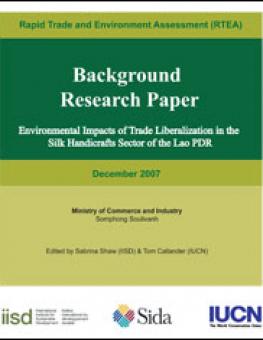
Environmental Impacts of Trade Liberalization in the Silk Handicrafts Sector of the Lao PDR
Demand for Lao's naturally dyed and often handmade silk products is growing steadily and providing key export earnings and potential opportunities for domestic producers. This paper examines the environmental impacts of this growth sector and finds an inherently environmentally-friendly industry with the potential to avoid negative impacts and capture the potential of green markets.
Key findings:
-
Demand from regional and international markets for Lao silk handicrafts is growing steadily. The most important development for this sector in recent years has been the resumption of Normal Trade Relations with the United States—now a key export market for Lao silk handicrafts.
-
The handicrafts sector in Lao PDR consists predominately of small family businesses spread across the country in rural and urban areas. Mainly due to the small and dispersed nature of these businesses, the sector remains largely unorganized and there are presently many barriers to supplying international markets such as supply of raw material inputs, supply of end products, lack of quality assurance, national standards and certification.
-
As the sector attempts to scale-up its production to meet increasing demand, there is potential for negative environmental impacts to occur, such as increased water consumption and water pollution as production increases. There is also potential for positive impacts to arise from increased international demand for natural "green" silk handicrafts produced in an environmentally-sound manner.
Key recommendations:
-
implement the National Export Strategy and work with the Lao Handicraft Association and the Lao National Chamber of Commerce and Industry through the creation of a silk handicraft fund to promote this sector;
-
work with industry actors to improve environmental performance by redesigning waste-water treatment systems, reducing water used in the production process by recycling waste water and upgrading to technologies that have fewer environmental impacts; and
-
enable the Lao silk handicrafts sector to grow sustainably through initiatives such as an annual environmental performance award to recognize quality and raise awareness of Lao brand-name silk products.
Additional downloads
You might also be interested in
Will the Inclusion of Voluntary Standards in Trade Agreements Lead to More Sustainable Trade?
The use of voluntary sustainability standards (VSSs) and similar systems in free trade agreements (FTAs) is gaining traction. Will it lead to more sustainable production and consumption globally?
Strategic Environmental Assessment for the Mining Sector
Strategic environmental assessments (SEA) are an essential tool for policy-makers working to develop a sector-wide vision for responsible mining.
Blackouts and Backsliding: Energy subsidies in South Africa 2023
Blackouts and Backsliding presents the latest energy subsidy data for South Africa.
Sustainable Asset Valuation of Parques del Río Norte in Medellín, Colombia
This economic valuation demonstrates the benefits of expanding urban green space in the city of Medellín, Colombia.